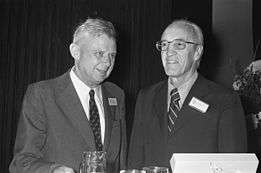Arthur D. Hasler

Arthur Davis Hasler (January 5, 1908 – March 23, 2001) was an ecologist who is credited with explaining the salmon's homing instinct.[1][2][3] Hasler was a member of the National Academy of Sciences and the American Academy of Arts and Sciences.[1] The New York Times called him "an internationally recognized authority on freshwater ecology".[1] He served as President of The Ecological Society of America,[2] which called him "one of the leading figures in 20th century freshwater ecology".[2] Hasler pioneered a research method based on manipulation of entire lake ecosystems. This method became an instrumental new tool for ecology.[3] He published over 200 scientific papers, was an author or an editor of 7 books, and supervisor of 52 doctoral degrees.[4]
Career
Hasler was born in Lehi, Utah. He married Hanna Prusse in 1932, and they had six children: Sylvia, A. Frederick, Bruce, Galen, Mark, and Karl.[3] He graduated from Brigham Young University in 1932. He received a doctorate in zoology from the University of Wisconsin–Madison in 1937.[3] Hasler was an analyst with the Air Force Strategic Bombing Survey based in Germany after World War II.[1] Hassler was a Fulbright scholar at the Max Planck Institute in Germany during 1954-1955.[4] Subsequently, Hasler was on the faculty of the University of Wisconsin–Madison for 41 years and under his leadership it became a hub for lake research.[1] In 1961 he served as President of The Ecological Society of America.[2] In 1969 he was elected to the National Academy of Sciences.[4]